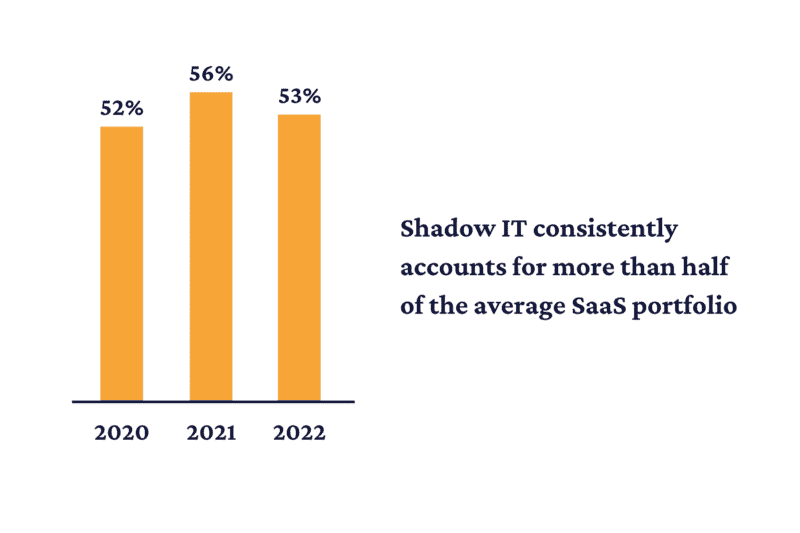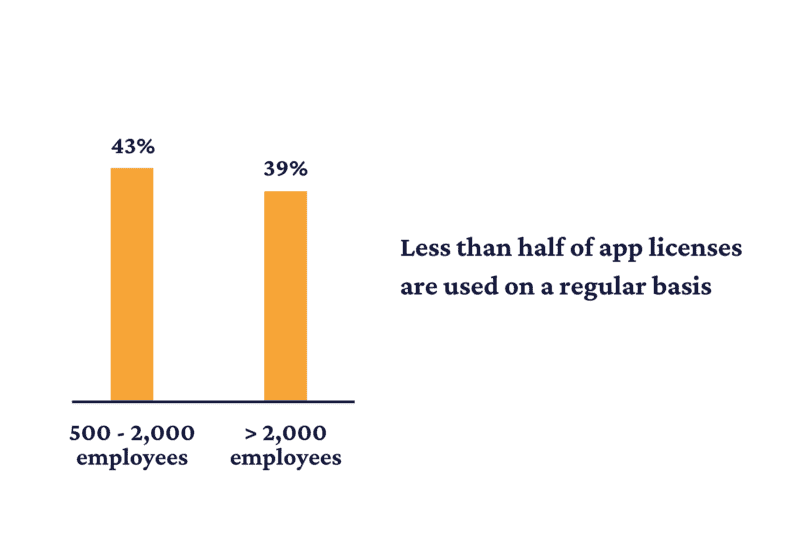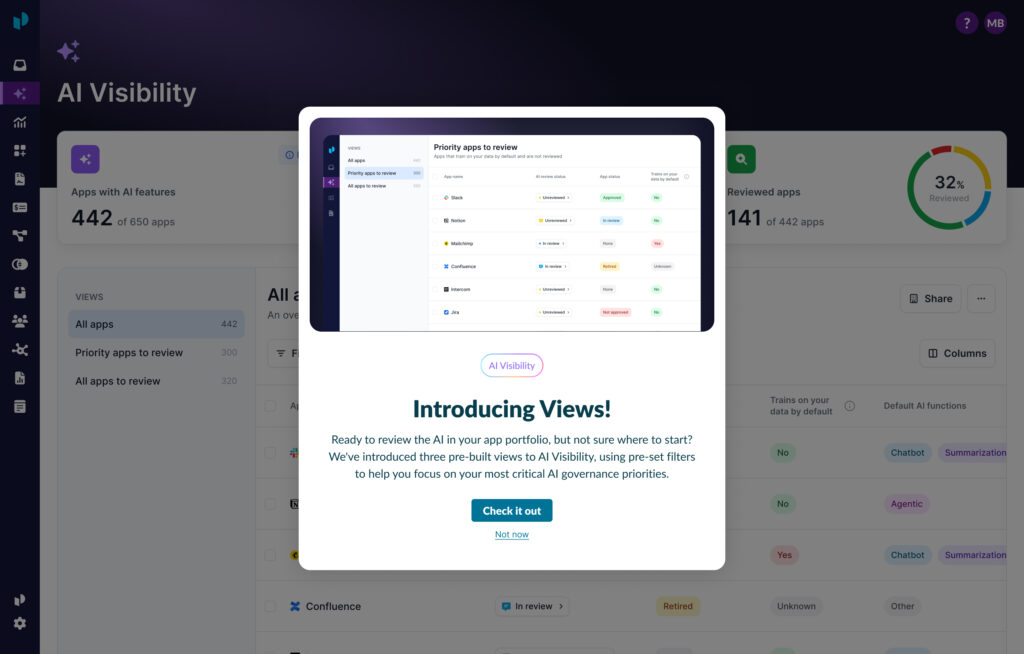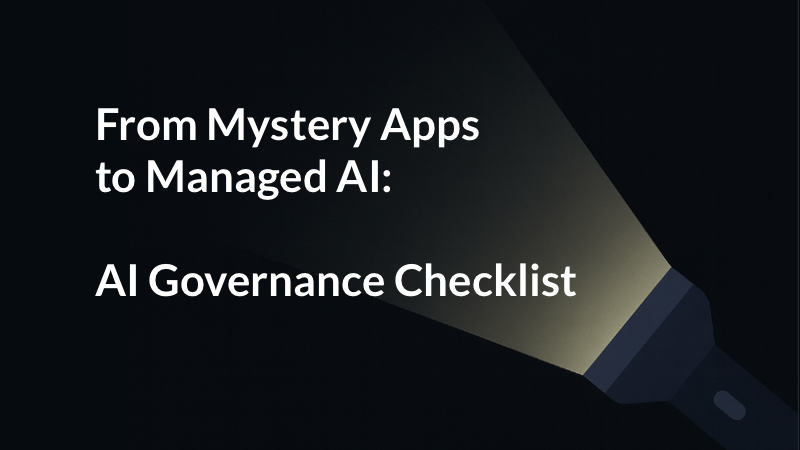
Control Your SaaS Spend: What Has Companies Wasting up to $40M Annually
By Alec Woodward and Todd Idler
Executive Summary
Today, cloud technologies make up 58% of application software spend, a number that’s only growing. And IT’s lack of visibility is increasing as well, with 56% of apps owned outside of a company’s IT department in 2021. As a result, IT teams struggle to identify unused and underutilized licenses across their company’s SaaS portfolio. This can lead to up to $40M in wasted spend annually — a huge issue for IT in today’s uncertain financial environment in which controlling SaaS spend is paramount.
Effective SaaS management provides the insights IT leaders need to identify and remedy this wasted spend. And with the right tools, SaaS management is straightforward and easy to implement. By gaining visibility into spend per app, the number of licenses used, and employee app engagement, IT leaders are already controlling SaaS spend to reduce costs up to 55%.
What is SaaS spend and how does it differ from cloud spend?
Before diving into the latest SaaS spend trends and how you can reduce wasted SaaS spend, let’s take a moment to define what we are examining. SaaS spend refers to the amount of money that an organization spends on acquiring and using software-as-a-service (SaaS) applications. These costs include licensing and subscribing to SaaS applications, and may also include additional fees such as implementation, customization, and support services.
It’s important to note that cloud spend and SaaS spend are two different things; SaaS spend is a subset of cloud spend. Cloud spend encompasses everything the organization spends on cloud computing services, including infrastructure-as-a-service (IaaS), platform-as-a-service (PaaS), SaaS solutions, cloud storage, and cloud security.
SaaS spend and popularity continues to rise
Today, cloud solutions make up 58% of application software spend. And that number is set to jump to 66% by 2025. This trend is driven by how easy it is for these SaaS apps to be purchased, deployed, and used.
While the increased productivity is a boon, the ease of acquisition has created a number of problems for IT. In 2022, as SaaS sprawl continued, business units outside of IT owned 53% of a company’s apps. Over the past three years, this shadow IT has accounted for more than half of the average company’s SaaS portfolio. As a result, controlling SaaS spend is difficult as IT leaders can’t easily identify where to optimize costs.

Figure 1: The percentage of shadow IT in the average SaaS portfolio from 2020 – 2022
How you could be losing up to $40M annually
IT’s lack of visibility and insight has huge implications for businesses of all sizes. To understand the impact, we looked at an anonymized subset of data in our platform across tens of thousands of SaaS apps. We found that the average organization used less than half of its app licenses on a regular basis.

Figure 2: The percentage of app licenses used by company size
With the average annual spend per employee on apps being $13K, the potential waste from unused and underutilized licenses alone can range from $7M–40M annually for organizations of 1,000–5,000 employees.
This is a huge issue for IT in today’s uncertain financial environment. CFOs surveyed by Deloitte this year said they use a cost/revenue ratio as one of the two top metrics for measuring the effectiveness of the IT function. If revenue goes down, they’ll look for ways to reduce costs to ensure the ratio doesn’t increase. And since SaaS is such a high portion of software spend, CFOs will be calling on IT to reduce SaaS spend.
If you don’t know where this spend is happening in the organization or how employees are using apps, you aren’t able to have effective conversations with procurement and business leaders about where spend can be optimized. As a result, you’ll need to cut based on hunches, not data. This not only reduces your effectiveness as an IT leader, it also has a negative impact on your company’s performance.
The top risks of overspending on SaaS
It’s easy to overspend on your SaaS portfolio if you’re not properly tracking and managing the use and cost associated with SaaS apps. It’s also easy to underestimate the impact that could have on your business.
Here are the top four risks associated with overspending on SaaS apps that you should be aware of:
- Budget overruns: Overspending on SaaS apps can result in budget overruns and strain on an organization’s finances. This is the risk you’re most likely aware of, but it’s important to keep in mind the rippling impact this can have on your organization’s financial stability, including the ability to fund other important projects or initiatives.
- Wasted resources: Some overspend can be tolerated if that spend is going toward apps and features that are actually being used. But we see that organizations continue to spend large sums of apps and features that teams either don’t need or no longer use. In addition to draining resources, this software bloat can also decrease the overall productivity of the organization.
- Vendor lock-in: If you aren’t able to identify that you’re overspending on an app or that it isn’t bringing value quickly enough, you can end up renewing and locking into long-term contracts with those vendors. This makes it difficult to switch to a more cost-effective solution if and when you identify the issue. As a result, it can limit your organization’s flexibility and hinder its ability to adapt to changing business needs.
- Security and compliance risks: Without proper SaaS spend management, the number of shadow apps used by your organization is likely to grow. These unapproved applications may not meet the organization’s security and compliance requirements and can increase your exposure to data breaches and regulatory fines, as well as damage your organization’s reputation.
What are the benefits of managing SaaS spend?
The benefits of managing SaaS spend go beyond just simple cost savings. There are a variety of short term and long term benefits your organization can realize with effective SaaS spend management.
Cost control
By analyzing SaaS spend, you can identify opportunities to optimize their software usage and reduce costs. This includes identifying underutilized applications or redundant features that can be eliminated, negotiating better pricing with vendors, and managing license usage to avoid overpaying for licenses that are not needed.
Better budget planning
SaaS spend tracking helps you to better plan and forecast your software expenses. This includes understanding how much is spent on each application, department, and employees, as well as identifying the largest cost drivers and developing budgets for future software investments.
Improved vendor management
Managing SaaS spend can also help you develop a better understanding of your relationship with vendors. This includes identifying areas for improvement, negotiating better contracts and service level agreements (SLAs), and ensuring that you are getting the best value for your money.
Increased visibility
Putting systems in place to help you manage SaaS spend can also provide you with greater visibility into software usage patterns. This includes identifying which applications are being used the most, which teams or departments are using the most software, and which features are the most popular. This visibility helps inform decisions about software investments and optimizations.
Compliance and security
Managing SaaS spend can help organizations ensure compliance with regulatory requirements, such as data privacy regulations, and maintain security standards by identifying potential vulnerabilities and ensuring that all applications are properly licensed and up-to-date.
How to control SaaS spend
IT needs a system of record that tracks all SaaS apps across the organization. That visibility is the first step in implementing a data-driven approach to optimize your app portfolio and reduce wasted SaaS spend. Here are ways to help you control SaaS costs:
1. Align around a unified view
A unified view of all SaaS apps becomes a shared truth between IT, Procurement, and line of business leaders. And when the entire business can easily access trustworthy data, collaborating on governance and decisions about app consolidation and license assignments comes naturally.
You’ll know how much you’re spending per app and per team. And with access to benchmarks, you can quickly see how your costs match up with similar purchases by other companies. From there, you can have data-driven conversations about which tools are most essential and where you might be overspending.
2. Learn from app usage
By understanding how one team uses an app and its features, then comparing it to how another team uses a different app, you can get insights into whether the app is used for the same reasons.
If the usage is similar, you might have a candidate for rationalization. If the features used are different, you could consider another app that can satisfy both business needs.
3. Rightsize accordingly
Knowing what apps teams are using and how they are using them gives you actionable intelligence for license rightsizing. You can confidently reduce the number of unused and underused licenses, so you’re only paying for what you actually use.
In addition to being useful at renewals, these insights can help you reharvest licenses on the fly for assignment to employees who need access to the app or specific features. Increasing the adoption of the licenses you currently own is another way to reduce wasted SaaS spend.
Also, for apps with license tiers, employees who aren’t using the features only available in their current license tier can be downgraded to a lower tier with the subset of features they do use. This frees up the higher cost licenses for other employees.
Success stories of companies managing SaaS spend
IT Leaders have quickly been able to reduce app costs by 35%
Gartner estimates that as much as 55% of SaaS spend is wasted or heavily underutilized. Effective SaaS management helps you actively — and continuously — manage your app portfolio and spend to reduce that waste. All the more, you can use these SaaS insights to align with Finance and other business areas for larger spend management initiatives. This will help keep costs in line with revenue while making sure your business keeps performing well.
Databricks optimized licenses across a number of apps with the help of employee usage insights. It avoided a 35% increase in Zoom costs by moving employees who were not using paid features down to the free version. It then reclaimed the higher tier licenses for assignment to new employees. Also, with the help of granular usage data, Databricks reduced the number of licenses needed for Asana by 35%. Learn more about how Databricks cut app costs.
United Talent Agency (UTA) used feature-level insights to understand where the adoption team needed to focus their efforts. They identified which critical app features were being underutilized and created specific training to drive the adoption of those features. Through this method, they increased Zoom screen sharing by 113% in 30 days and increased Box user engagement by 59%. Additionally, training for the file sharing feature in Box resulted in a 422% rise in Box files shared externally. Read the full case study to learn more.
What’s next?
See how to start reducing SaaS waste today with the SaaS Intelligence™ Cost Optimization Framework.
Get more tips on how to improve ROI across your SaaS investments.
Schedule a demo of Productiv SaaS Intelligence™ Platform, the data-driven approach to SaaS management.
About Productiv:
Productiv is the IT operating system to manage your entire SaaS and AI ecosystem. It centralizes visibility into your tech stack, so CIOs and IT leaders can confidently set strategy, optimize renewals, and empower employees.





